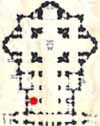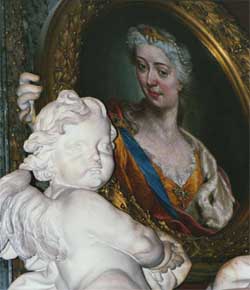| Grottoes
Vatican City Colonnade Saints Floorplan #2 |
| Altars
Monuments The History |
|
Related Sites |
|
Maria Clementina Sobieska (1702-1735) is one of three women honored with monuments in the basilica. She was niece to the King of Poland and married to the Pretender of the English throne, James III Stuart . She looks down from her monument to that of her husband and sons. At the age of 33, she died of tuberculosis and was buried in St. Peter's |
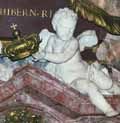 |
 |
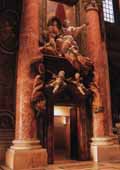 |
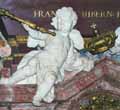 |
From:
St. Peter's - Guide to the Basilica and Square
Under the next arch on the right is the Monument to Maria Clementina Sobieska
(1702-1735), niece of King John II or Poland, who in 1719 married the
Pretender to the throne of England, James III Stuart. The princess is
portrayed in a medallion held up by a cherub and by the statue representing
Charity, the work of Pietro Bracci (1700-1773).
From:
'St. Peter's Basilica - A Virtual Tour' by Our Sunday Visitor
In the passage toward the last Chapel, on the outside wall over the door
leading to the dome, is the Monument to Maria Clementina Sobiesky, who
died in 1735 and was the wife of James III, pretender to the throne of
England.
Designed by Filippo Barigioni, with sculptures by Pietro Bracci and work in metal by G. Giardini, it is typically 18th century in its overall graceful elegance, especially in the elaborate hairstyle of the deceased, executed in mosaic by Pietro Paolo Cristofari from an original by Ignaz Stern, and in the grace of the two small white marble putti which stand out well against the parallel veining of the marble pall. The emphatic figure of Charity, holding a portrait of the deceased in one hand and raising a flaming heart in the other, seems to be a last embellished manifestation of Baroque style.
From:
A Jacobite Gazetteer - The Vatican
The monument to Queen Clementina (wife of King James III and VIII) is
in the left aisle of St. Peter's Basilica immediately opposite the Monument
to the Stuart Kings. It is above the doorway from which people exit having
descended from the roof and the dome. The monument was erected at the
expense of the Reverenda Fabbrica di S. Pietro (the body responsible for
the upkeep of the basilica). It was completed in December 1742.1
Above a porphyry sarcophagus surrounded in pink marble is a white marble figure of Charity raising heavenward the enflamed heart of the queen. To the left of Charity is a putto (an angelic figure); between them they bear a mosaic portrait of Clementina who wears the blue sash of the Order of the Garter. Below the sarcophagus two marble putti play, one with a gold sceptre and the other with a gold crown. At their feet, above the door, is a gold wreath with a gold ribbon across it bearing the Latin inscription: "IV· KAL· FEBR" (January 29th, the date of Queen Clementina's death).
The monument was designed by Filippo Barigioni. The figures were sculpted by Pietro Bracchi. The mosaic was executed by Pietro Paolo Cristofari based on an oil painting by Ignaz Stern. The gold decoration was the work of Francesco Giardoni.2
Notes
1 Chracas 3960 (December 13, 1742) (http://members.tripod.it/Sichem/chracas2.htm).
2 Ibid. The
architect Filippo Barigioni was born in 1690, and died in 1753. The sculptor
Pietro Bracci was born in Rome in 1700, and died in the same city in 1773;
he also designed an uncompleted monument to the memory of King James III
and VIII. Pietro Paolo Cristofari was born in 1685, and died in 1743;
he is responsible for a number of the mosaics in St. Peter's Basilica.
The painter Ignaz Stern was born in Mauerkirchen, Bavaria in 1679, and
died in Rome, in 1748.
The Latin inscription
on the sarcophagus reads as follows:
MARIA CLEMENTINA M. BRITANN. - (Maria Clementina, of Great Britain)
FRANC. ET. HIBERN. REGINA - (France and Ireland, Queen)
At her death in 1735,
the body of Queen Clementina was placed in the crypt. In 1745, however,
it was moved near to her monument at the base of the staircase to the
cupola. A Latin inscription marks the spot:
CORPVS
MARIAE CLEMENTINAE MAGNAE BRITANNIAE REGINAE
XV. KAL. FEBRVAR. MDCCXXXV
AETATIS SVAE XXXIII. ET. MENS. VI. DEFVNCTAE
IN HVIVS BASILICAE CRYPTIS POSITVM
HVC DIE XXII. MENSIS IANVARII ANNO MDCCXLV
TRANSLATVM ET RECONDITVM EST
